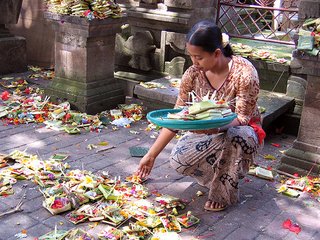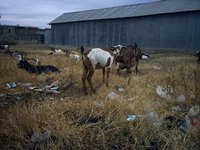[ . BACK to Worldkigo TOP . ]
:::::::::::::::::::::::::::::::::::::::::::::::::::::::::::::::::::::::::::::::::::::::::::::::::::::
Frangipani, Plumeria
***** Location: Kenya, India, Australia and other tropical countries
***** Season: Hot dry season, cool dry season
............. Summer in Australia and India
***** Category: Plant
*****************************
Explanation
Frangipani trees are planted in Nairobi here and there, in public parks and large gardens, usually just one or two, as they need space and attract plenty of attention. In Mombasa and at the Indian Ocean coast, around the famous beach resorts, they are planted together with bougainvillea and poinsettia and provide a special attraction for tourists.
This small tree has a striking appearance, with long bare elephantine branches, a small tuft of leaves at the end of each branch, the tip studded with scented flowers.
Kenya has several bulbs, shrubs and trees with a delicious perfume... but of all these, the frangipani tree and its blossom also have the most beautiful appearance.
The frangipani tree is much beloved by the Hindu community of Kenya, who present its flowers as offerings in their temples. One can see piles of the flowers in Mombasa temples in the morning, brought in by the faithful.
Some of the airlines display just one or two fresh frangipani flowers in their WCs en route from Kenya to Europe -- a natural perfume which quite fills the cell with its fragrance.
Isabelle Prondzynski
xxxxxxxxxxxxxxxxxxxxxxxxxxxxx

©
http://www.xcalak.info/visit/uk/plants-uk.shtml
xxxxxxxxxxxxxxxxxxxxxxxxxxxxx
Frangipani, Temple Tree
Plumeria spp. Family : Apocinaceae
This is a familiar shrub, almost a small tree, having a characteristic appearance, with rather thick, smooth, green twigs which branch regularly and ooze large quantities of latex if damaged. It is often planted near temples and in cemeteries in India and South East Asia.
The white variety (P. alba) originates from the West Indies and is named after the Frenchman Plumier, who was a pioneer of West Indian botany. The pink-flowered Frangipani (P. rubra) comes from Central America and now has a wide range of allied colours.
It is suggested that the name Frangipani originates from the French frangipanier, meaning coagulated milk; but a more attractive hypothesis refers to a perfume developed from its flowers in the 12th century by an Italian nobleman named Frangipani.
John Karmali, The Beautiful Plants of Kenya, Nairobi 1993.
xxxxxxxxxxxxxxxxxxxxxxxxxxxxx

Balinese girl in a Hindu Temple, Ubud, Bali,
Indonesia, August 2005
©
http://www.flickr.com/photos/pape/128564255/in/set-72057594063093676/
xxxxxxxxxxxxxxxxxxxxxxxxxxxxx
Plumeria rubra, Frangipani
A large, commonly seen succulent shrub that reaches 5 m in height. It is much favoured in the tropics, growing at altitudes from sea level to 2,000 m.
Bark : Grey, smooth, with prominent leaf scars.
Branches : Thick, forking, exuding a milky sap when wounded; sap very poisonous.
Leaves : Large; dark; leathery; lanceolate; in terminal bunches at the end of branches; tapering to base and apex; 20-22 cm across; prominent veins; regular, usually shed during the dry season, when flowers appear.
Flowers : White, yellowish, pink or reddish purple; 5 petals, overlapping at the centre and curled at the edges; 6 cm across; scented; in terminal bunches.
Fruit : Paired capsules up to 25 cm in length.
Uses : According to legend a 12th-century Italian called Frangipani combined certain volatile oils, including the oil of these flowers, to create an exquisite perfume, which made his name and fortune. Today the plant, to which many names and stories are attached, is widely cultivated throughout the tropics. In Asia, it is often grown near Buddhist temples, where it is known as the ‘pagoda tree’, and the flowers are sometimes called ‘temple flowers’. It is also frequently planted near graves, especially those of Muslims and Buddhists. The latex in the branches is poisonous, though apparently useful in the treatment of skin cuts and inflammation.
Najma Dharani, Field Guide to common Trees and Shrubs of East Africa, Cape Town 2002.
xxxxxxxxxxxxxxxxxxxxxxxxxxxxx

©
http://www.frangipani-aroma.com.au/Japanese/personalityjp.htm
*****************************
Worldwide use
India
In India, the name of frangipani is "
champa" or "chafa", in Telugu "Deva ganneru" (divine nerium), in Manipuri "Khagi Layhaaw"
Fragrant frangipani
THE FRANGIPANI is a popular tropical plant, growing to smallish tree-like proportions. As it is propagated both by way of seed and cutting, the plant is found almost everywhere in India, the East and the Far East.
The beauty of the flower, along with its fine wafting perfume, has made the flower a popular offering in Buddhist temples all over the East.
Of the Apocynaeceae family, its botanical name is Plumeria, after the French botanist Charles Plumer, who first found the plants in the Caribbean in the 17th Century.
The plant goes by various unusual names — `Dead Man's Fingers' in Australia, `Jasmin de Cayenne' in Brazil and `Pagoda' or `Temple Flower' in India. Frangipani came from `frangipanier' or coagulated milk, so called by the French settlers in the Caribbean in the 17th Century.
The P. Rubra is the most common of Plumerias and has given rise to many cultivars. Most common is the white with yellow centres, while other Rubras come in shades of red, pink, yellow and a mix of these colours.
The plants also do well in pots, needing strong sun and enough water. The leaves drop and flowering lessens, till the plant gathers strength to start blooming profusely again. A single frangipani tree in bloom will scent the air for quite a distance in the evenings, making it a beautiful acquisition to any home. The bunches of flowers make the tree attractive.
© RUPA GOPAL
http://www.hindu.com/mp/2004/06/03/stories/2004060300260300.htm
- - - - - and this blossom
Champa, Joy Perfume Tree - Magnolia champaca
The most interesting part of the tree are its flowers which are not very showy with few narrow yellowish white petals, but have an extremely heady fragrance. This fragrance has made Champa flowers very popular and they have been part of the culture in India from time immemorial. They are used in religeous offering in various parts of India. On a warm humid night, the scents can easily be enjoyed several hundred feet away. Champa flowers are used to make the world's most expensive perfume 'Joy' in America.
source : www.flowersofindia.net
between wedding
and the blooming of champa . . .
her tears
- Shared by Sandip Chauhan -
Haiku Culture Magazine, 2013
*****************************
Things found on the way
*****************************
HAIKU
Uhuru Park --
sweet scented sunshine under
the frangipani
Isabelle Prondzynski, Kenya
:::::::::::::::::::::::::::::::::::::::::::::::::::::::::::::::::::::::::::::::::::::::::::::::::::::
cloudy sky --
yellow frangipanni blooms
in green leaves
Patrick Wafula, Kenya
:::::::::::::::::::::::::::::::::::::::::::::::::::::::::::::::::::::::::::::::::::::::::::::::::::::

© becky blair. yellowhouseart
http://www.yellowhouseart.com/photos/work_details.asp?urn=1642
:::::::::::::::::::::::::::::::::::::::::::::::::::::::::::::::::::::::::::::::::::::::::::::::::::::
frangipani scent . . .
somewhere in my mind, the seed
of a haiku
Richard Kay, Australia
xxxxxxxxxxxxxxxxxxxxxxxxxxxxx
plumeria blooms
butterflies sparrows etch
my vast solitude ~
Narayanan Raghunathan
xxxxxxxxxxxxxxxxxxxxxxxxxxxxx
On my slow walk home
Saw a frangipani fall -
So I picked it up
Wing
http://blog.wingdingo.com/2007/01/03/frangipani/
:::::::::::::::::::::::::::::::::::::::::::::::::::::::::::::::::::::::::::::::::::::::::::::::::::::
beach sunset
a frangipani trodden
into wet sand
Sharon Trevelyan Dean
http://users.mullum.com.au/jbird/dreaming/ozku-beach.html
:::::::::::::::::::::::::::::::::::::::::::::::::::::::::::::::::::::::::::::::::::::::::::::::::::::
Some Haiku by Angelee Deodhar, India
frangipani blooms
softening iron balustrade
of the stone terrace
http://www.tempslibres.org/sites/ang/hku/ang04.html
windswept -
into the upside down umbrella
frangipani blossoms
http://www.geocities.co.jp/Bookend-Christie/5203/2004.html
end of summer
the first whisper of rain
on the frangipani
http://summerhaiku.blogspot.com/2006_07_01_summerhaiku_archive.html
xxxxxxxxxxxxxxxxxxxxxxxxxxxxx
starless night
frangipani blossoms
litter the lawn
Sue Mill
Copyright 2003 Simply Haiku
http://www.poetrylives.com/SimplyHaiku/SHv1n6/Sue_Mill.html
:::::::::::::::::::::::::::::::::::::::::::::::::::::::::::::::::::::::::::::::::::::::::::::::::::::
strewn, grounded
white frangipani flowers~
petals of autumn
- Shared by Mark Phillip Liston - Newcastle, Australia
Joys of Japan, 2012
*****************************
Related words
*****
:::::::::::::::::::::::::::::::::::::::::::::::::::::::::::::::::::::::::::::::::::::::::::::::::::::
[ . BACK to WORLDKIGO TOP . ]
:::::::::::::::::::::::::::::::::::::::::::::::::::::::::::::::::::::::::::::::::::::::::::::::::::::































